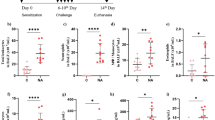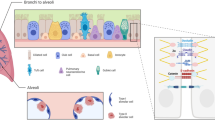Abstract
Tumor necrosis factor α and interleukin-1β increase surfactant secretion in type II pneumocytes in a time- and dose-dependent manner. This stimulatory effect was additive to that of lipopolysaccharide, suggesting that cytokines and lipopolysaccharide may exert their actions through different signal transduction pathways. Tumor necrosis factor α and interleukin-1β did not modify the increase on phosphatidylcholine secretion induced by the direct protein kinase C activator tetradecanoylphorbol 13-acetate, whereas this effect was inhibited by the protein kinase C inhibitors bisindolylmaleimide (2 × 10-6M) and 1-(5-isoquinolinylsulphonyl)-2-methyl piperazone (10-4M). In addition, the stimulatory effect of tumor necrosis factor α and interleukin-1β was not suppressed by the intracellular Ca2+ chelator BAPTA (5 × 10-6M) or by KN-62 (3 × 10-5M), a specific inhibitor of Ca2+-calmodulin-dependent protein kinase. These results suggest that tumor necrosis factor α or interleukin-1β stimulate phosphatidylcholine secretion via protein kinase C activation in a Ca2+ -independent manner.
Similar content being viewed by others
References
Tracey M, Beutler B, Lowry SF, Merryweather J, Wolpe S, Milsark IW, Hariri RJ, Fahey TJ, Zentella A, Alber JD, Shires GT, Cerami A: Shock and tissue injury induced by recombinant human cachectin. Science 234: 470–474, 1986
Tracey M, Lowry SF, Cerami A: Cachectin/TNFα ?in septic shock and septic adult respiratory distress syndrome. Am Rev Respir Dis 138: 1377–1379, 1988
Stephens KE, Ishizaha A, Wu Z, Larrick JW, Raffin TA: Tumor necrosis factor causes increased pulmonary permeability and edema: Comparison to septic acute lung injury. Am Rev Respir Dis 138: 1300–1307, 1988
Okusawa S, Gelfand JA, Ikejima T, Connolly RJ, Dinarello CA: Interleukin I induces a shock‐like state in rabbits. Synergism with tumor necrosis factor and the effect of cyclooxygenase inhibition. J Clin Invest 81: 1162–1172, 1988
Tubar DR, Burchett SK, Jacobs RF: Enhanced production of monokines by canine alveolar macrophages in responses to endotoxininduced shock. Proc Soc Exp Biol Med 187: 408–415, 1988
Nash JRP, McLaughlin J, Hoyle C, Roberts D: Immunolocalization of tumour necrosis factor alpha in lung tissue from patients dying with adult respiratory distress syndrome. Histopathology 19: 395–402, 1991
Van Golde LMG, Batenburg JJ, Robertson B: The pulmonary surfactant system: biochemical aspects and functional significance. Physiol Rev 68: 374–455, 1988
Wright JR, Clements JA: Metabolism and turnover of lung surfactant. Am Rev Respir Dis 136: 426–444, 1987
Harwood JL: Lung surfactant. Prog Lipid Res 26: 211–256, 1987
Barrow RE, Hills BA. Surface tension induced by dipalmitoyl lecithin in vitro under physiological conditions. J Physiol 297: 217–227, 1979
Chander A, Fisher AB. Regulation of lung surfactant secretion. Am J Physiol 258: L241–L253, 1990
Wright JR, Dobbs LG: Regulation of pulmonary surfactant secretion and clearance. Annu Rev Physiol 53: 395–414, 1991
Rooney SA, Young SL, Mendelson CR: Molecular and cellular processing of lung surfactant. FASEB J 8: 957–967, 1994
Romero C, Benito E, Bosch MA: Effect of Escherichia coli lipopolyssacharide on surfactant secretion in primary cultures of rat type II pneumocytes. Biochim Biophys Acta 1256: 305–309, 1995
Reid T, Ramesha CS, Ringold GM: Resistance to killing by tumor necrosis factor in an adipocyte cell line cause by a defect in arachidonic acid biosynthesis. J Biol Chem 266: 16580–16586, 1991
Guy GR, Chuan SP, Wong NS, Hg SB, Tan YH: Interleukin I and tumor necrosis factor activate common multiple protein kinases in human fibroblasts J Biol Chem 266: 14343–14352, 1991
Ferro TJ, Parker DM, Commins LM, Phillips PG, Johnson A: Tumor necrosis factor‐alpha activates pulmonary artery endothelial protein kinase C. Am J Physiol 264: L7–L14, 1994
Aracil FM, Bosch MA, Municio AM: Influence of E. coli lipopolyssacharide binding to rat alveolar type II cells on their functional properties. Mol Cell Biochem 68: 59–66, 1985
Dobbs LG, González R, Williams MC: An improved method for isolating type II cells in high yield and purity. Am Rev Respir Dis 134: 141–145, 1986
Edelson JD, Shannon JM, Mason RJ: Alkaline phosphatase: A marker of alveolar type II cell diferentiation. Am Rev Respir Dis 138: 1268–1275, 1988
Bligh EG, Dyer W: A rapid method of total lipid extraction and purification. Can J Biochem Physiol 37: 911–917, 1959
Benford DJ, Hubbart SA: In: K. Snell and B. Mullok (eds). Biochemical Toxicology: A Practical Approach. IRL Press, Oxford, 1987, p.74
Tsien RY: New calcium indicators and buffers with high selectivity against magnesium and proteins: Design, synthesis and properties of prototype structure. Biochem 19: 2396–2404, 1980
Grynkiewicz G, Poenie M, Tsien RY: A new generation of Ca2+ indicators with greatly improved fluorescence properties. J Biol Chern 260: 3440–3450, 1985
Byrne K, Carey PD, Surgerman W: Adult respiratory distress syndrome. Acute Care 13: 206–234, 1987
Dobbs LG, Mason RJ: Pulmonary alveolar type II cells isolated from rats. Release of phosphatidylcholine in response to β‐adrenergic stimulation. J Clin Invest 63: 378–387, 1979
Sano K, Voelker DR, Mason RJ: Involvement of protein kinase C in pulmonary surfactant secretion from alveolar type II cells. J Biol Chem 260: 12725–12729, 1985
Ho AK, Thomas TP, Chik CL, Anderson WB, Klein DC: Protein kinase C: Subcellular redistribution is increased by Ca2+ influx. Evidence that Ca2+‐dependent subcellular redistribution of protein kinase C is involved in potentiation of β‐adrenergic stimulation of pineal cAMP and cGMP by K+ and A23187. J Biol Chem 263: 9292–9297, 1988
Nishizuka Y: Intracellular signaling by hydrolysis of phospholipids and activation of protein kinase C. Science 258: 607–614, 1992
Nishizuka Y: Protein kinase C and lipid signaling for sustained cellular responses. FASEB J 9: 484–496, 1995
Author information
Authors and Affiliations
Rights and permissions
About this article
Cite this article
Benito, E., Bosch, M.A. The inflammatory cytokines tumor necrosis factor α and interleukin-1β stimulate phosphatidylcholine secretion in primary cultures of rat type II pneumocytes. Mol Cell Biochem 189, 169–176 (1998). https://doi.org/10.1023/A:1006997731607
Issue Date:
DOI: https://doi.org/10.1023/A:1006997731607




